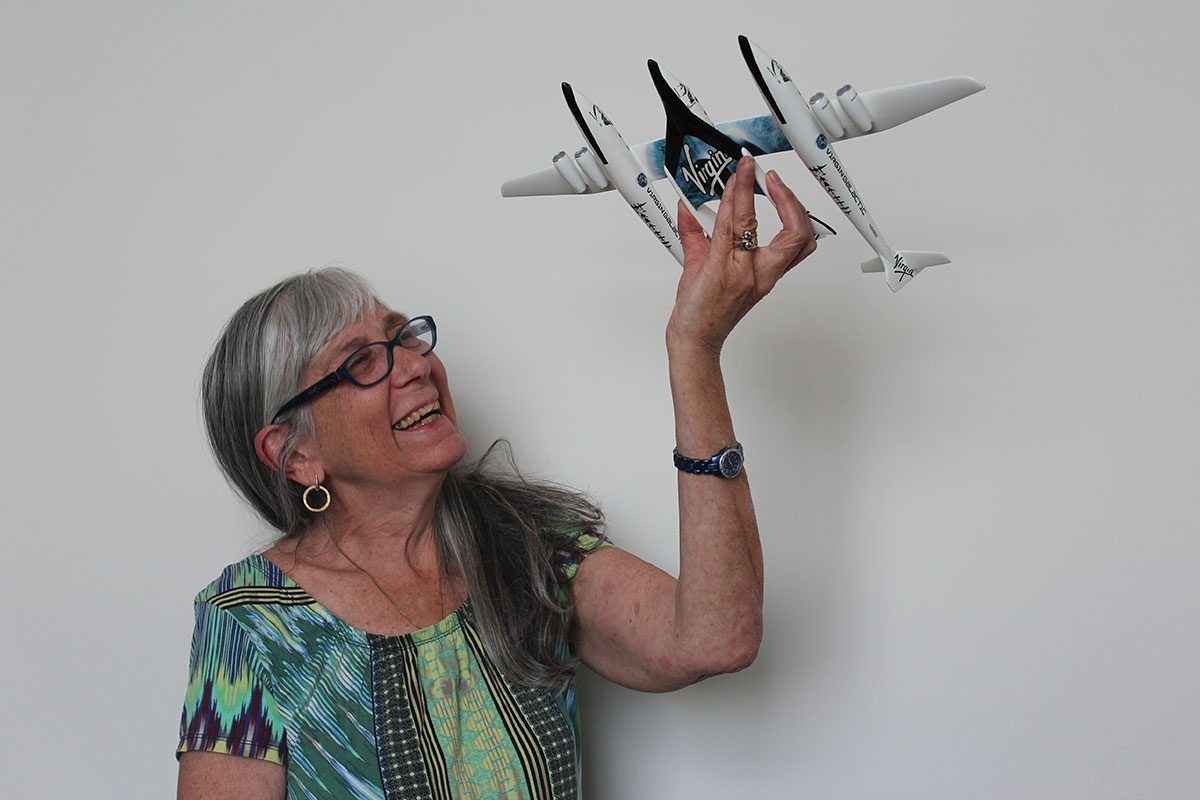
Judy Anderson holds a model of a Virgin Galactic spaceship. // Photo by Chris Reid
Destination in the stars
Judy Anderson is going to space. She is absolutely certain of it.
“I grew up wanting to go to the moon,” she explains. “Ever since [Yuri] Gagarin went up, it’s something I’ve always wanted to do!”
Although Anderson has officially stepped down from teaching and her position as head of the department of biological sciences in the Faculty of Science, she insists on qualifying her status.
“I’m not really retiring, at least not yet – I have a lot more to do!”
Anderson gradated from the U of M in 1981 with a bachelor of medicine and then took three years of medical school before shifting into research.
She followed her passion for studying the human condition and graduated with a doctorate in human anatomy in 1984.
Following a few years as a post-doctoral teaching fellow in anatomy at UBC, Anderson returned home to the U of M in 1988 and joined the Faculty of Medicine. Since then, she has held numerous positions including associate dean and then acting dean of medicine.
She was the head of biological sciences from 2007 until this July.
As a cell biologist, Anderson “opened up” the field of stem cell biology through her work on stem cells (called “satellite cells”) in skeletal muscle. These cells are kicked into action with the introduction of nitric oxide. They have been shown to have great potential in the treatment of various diseases, and dosing them with nitric oxide increases their efficacy in muscle repair and growth.
Anderson says stem cell research has opened many doors for the research community worldwide, leading to life-saving applications including the possible reversal of major illnesses such as muscular dystrophy.
“We’re still a long way from complete cures, but collaborative research in the field is the only way to get there,” she explains.
Admittedly, stem cell research is somewhat removed from space travel. Yet Anderson insists the connection can be made: muscles atrophy in microgravity during space travel, and her discovery about nitric oxide has led to fascinating work in the lab.
“I like to observe patterns in nature” she says. “The growth of muscle cells within the body and the way that plasma structures move about on the surface of the Sun are both fascinating to me.”
The latter phenomenon is something upon which Anderson spends much time each year, as she and her partner Jay Anderson are seriously “hooked” on total solar eclipses.
Formerly with Environment Canada, Jay has taught occasional courses in meteorology, climate change, and storm chasing for the past 10 years in the Clayton Riddell Faculty of Environment, Earth and Resources.
Jay is recognized globally as an expert on eclipse climatology and finding just the right spot with the best chances of clear weather wherever the Moon’s shadow traces across the earth. He and Judy travel the world chasing solar eclipses for a few minutes of totality. (They will be in Wyoming this month for the 2017 solar eclipse.)
The longest eclipse they witnessed was in La Paz in Baja California in 1991, which lasted nearly seven minutes, while the “best one” was a 13-second glimpse of beauty in Uganda in 2013 that was spectacular for colour and setting. But the most remarkable for Judy, was in Indonesia in 2016.
“During that eclipse, there was a huge prominence of plasma, glowing red and ejected from the sun,” she explains. “Streams of plasma twisted around each other like cables and then sprayed out above the sun’s surface. It was amazing and visible through the whole eclipse, meaning it was really huge.”
“Who would have thought that the world could ever show you something like that, and that I could see it?” she asks, wistfully.
Anderson’s literally “star-struck” nature and her interest in space since childhood led her to take the next logical step in her scientific curiosity: a step completely off the planet (well, maybe not so logical).
“It was in about 2009 when billionaire Richard Branson announced that his company, Virgin Galactic, would be taking passengers into space aboard SpaceShipTwo, designed as a new sub-orbital space plane. I couldn’t resist the dream of floating in weightlessness and seeing the earth from space, so I made a down payment for my $200,000 (US) ticket,” she recalls.
Despite problems that necessitated redesign of the spacecraft, Branson anticipates that public flights will begin sometime in 2019. (“I can’t wait!” she says.)
Following inaugural flights by Branson and his family, Anderson expects that passenger flights could begin by 2020. When fully operational, Virgin Galactic will take six passengers at a time, with as many as 100 launches every year.
“I’ve got ticket number 623,” she says proudly. “I really hope to go up within five years.”
Although NASA astronauts endure rigorous training for space flight, Branson’s passengers only need basic familiarization with the craft and sub-orbital flight process. Anderson went to the NASTAR facility in Pittsburgh as part of a research project for training on their huge centrifuge, and handled ten G’s with no problem.
“It was the best possible roller coaster, ever!” she says.
Aside from that, she will be going up with no other training except keeping healthy and fit, and doing the familiarization that Virgin Galactic provides at SpacePort in New Mexico, in advance of the launch for each astronaut.
“I’m not pulling out of the program,” she insists. “I want to feel weightless and do some little experiments before, during, and after. It will be the experience of a lifetime.” She’s got a feather to take up with her, and is waiting to find out the weight allowance. There’s probably no check-in bag allowed, though.
“I’m going to space!”
Anderson’s determination and her exuberant enthusiasm to experience natural wonders has influenced her research and also her managerial style and interactions with co-workers.
“I am in awe of natural interactions, colours, and patterns. I love learning how things work – that’s probably why I’m a biologist,” she notes. “That curiosity can be applied to understanding people’s behaviour and communication, how we use our brains and how we can help others.”
“It’s the connections we make with others that help us grow into understanding ourselves. People are the world’s and the university’s best resource. You can’t just tell people what to do – it’s important to give your staff the benefit and the respect of listening to them, in the best interests of the greater community.”
As head, Anderson had a lead role in disaster recovery following a major fire in the Duff Roblin Building in 2009. She used all of her human resource management skills to oversee the recovery process across several departments and faculties, and learned much more in the process.
“It was only through finding ways to work effectively with all the groups and people involved that there could be a recovery process,” she says. “Even when things are very difficult and everyone is under stress, it really is possible to overcome adversity and achieve a goal.”
And Anderson’s goal is set firmly in the stars.
Judy Anderson will make a presentation at the Faculty of Science’s Women in Science – Homecoming luncheon on Tuesday, Sept. 12, starting at 12 p.m., in Marshall McLuhan Hall, UMSU University Centre.
Enjoy brief presentations, then spend some time face-to-face with each scientist, for smaller roundtable discussions.
For more information, visit the Homecoming website.







Dr. A is one of our fabulous women of science nurtured and nurturing at the University of Manitoba.
Cheers to your flight!
My dear colleague Judy, is indefatigable when it comes to all things biological! Her enthusiasm and curiosity are boundless – space is a most logical progression.